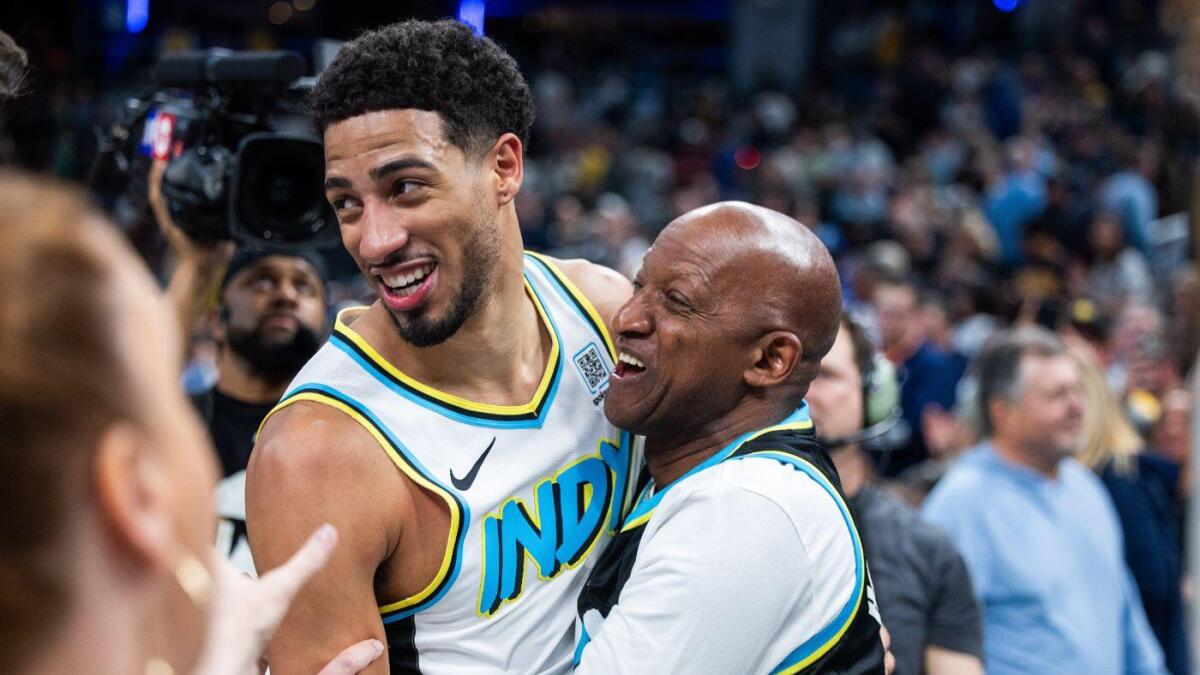Tyrese Haliburton’s dad recreating Reggie Miller’s infamous “choke” gesture has become a viral sensation, further enlivening the atmosphere surrounding the Indiana Pacers’ remarkable comeback and playoff success. This event intertwines sports history, family pride, fan culture, and media buzz, creating a rich narrative beyond the basketball court.
The Legacy of Reggie Miller’s Gesture
Reggie Miller’s “choke” sign is one of the most iconic and controversial moments in NBA history. During Game 5 of the 1994 Eastern Conference semifinals, Miller famously gestured to Spike Lee and Knicks fans, taunting them with a choking motion after clutch performances late in the game. The sign became a defining symbol of Miller’s confidence and rivalry with New York, embedding itself in basketball lore as both a celebration and provocation.
This gesture transcended mere hand signals to embody psychological warfare on the court, adding an edge to the already intense Pacers-Knicks rivalry. It also generated polarized views—celebrated by Pacers fans and criticized by Knicks supporters—reflecting how meaningful such symbolic actions can be in competitive sports.
Tyrese Haliburton Emulating Miller’s Gesture
During a pivotal playoff game, Tyrese Haliburton hit a clutch, game-tying shot against the Knicks that helped set up a historic Indiana comeback victory. After the moment, Haliburton celebrated by recreating Miller’s “choke” sign, paying homage to the Pacers’ great and linking himself to the franchise’s rich past. This moment was not just a celebration; it was a statement signaling composure under pressure and a connection to team identity.
The replication of this historical gesture by a younger star underscores basketball’s storytelling through tradition. It bridges generations—from Miller’s ’90s battles to today’s playoffs—showing how gestures carry emotional weight and narrative power in sports.
The Viral Sensation: Haliburton’s Dad Joins the Act
The celebration gained further traction when Haliburton’s father, seen courtside, also recreated Miller’s choke gesture in the postgame frenzy. This action sparked widespread attention on social media and among broadcasters, including emphatic reactions from basketball icons like Charles Barkley and Shaquille O’Neal.
This addition brings an intimate family angle to the tale. It shows how the spirit of the moment resonates beyond the player himself, involving his family and community. Haliburton’s dad echoing the gesture symbolizes support, pride, and a shared emotional channeling of the team’s victory and historic legacy.
Media Reactions and Commentators’ Take
The moment was met with enthusiasm and humor by observers. Analysts emphasized the gesture’s cultural weight and noted the strange but heartwarming scene of Haliburton’s dad mimicking a move that once ignited NBA crowds. Barkley called for the dad’s ban to be lifted from games, reflecting both amusement and recognition of the gesture’s fan-driven passion.
Shaq’s stunned reactions highlighted how rare and viral such candid family displays can be during high-stakes NBA moments. The media coverage tapped into nostalgia, referencing Miller’s era, while spotlighting Haliburton’s emergence as a franchise leader carrying forward Pacers tradition.
The Impact on Fan Culture and Team Identity
Recreating iconic celebrations enhances team identity and fan culture, fostering solidarity among supporters. Haliburton’s gesture links new Pacers successes to legendary moments, fueling fan excitement and extending franchise heritage.
Haliburton’s dad joining the celebration in the stands humanizes the spectacle, reminding fans that behind professional athletes are families who share the thrills of victory. Such moments deepen fan engagement and enrich the narrative of basketball as a communal and multigenerational experience.
Symbolism in Sport: Beyond the Game
The “choke” sign is more than mockery; it’s a layered symbol loaded with psychological intensity and historical significance. When Haliburton and his father perform it today, they invoke a legacy of resilience, rivalry, and boldness. It is a visual shorthand for confidence and mental fortitude—a message to opponents and fans alike.
The gesture’s revival shows how sports can recycle and reinterpret meaningful symbols to articulate identity, emotion, and team spirit in evolving competitive contexts.
Conclusion: A Gesture that Bridges Past and Present
Tyrese Haliburton’s clutch shot and his dad’s enthusiastic mimicry of Reggie Miller’s choke gesture have created a memorable chapter in Pacers lore. This convergence of history, family, and fandom captures the power of symbolic moments in sports—how a single gesture can ignite passion, recall legacy, and unify supporters across eras.
As the Pacers continue their playoff run, these vivid celebrations promise to stand as enduring testaments to the team’s grit and the timeless narratives sport crafts through its rituals and shared memories. The “choke” sign lives on, reinvented for a new generation, rallying hearts and voices in a collective cheer that transcends the scoreboard.





